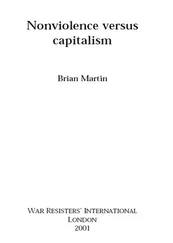Though meeting places may be instrumental toward nonviolent struggle, when they are in the hands of private developers, they may be a hindrance to social action. Owners of enclosed shopping centres may control such things as opening hours, entry and exit locations, who can lease shops, what notices can be put on public display, and even who uses their centre. Likewise, whole sections of the community can be similarly affected if private developers are given the go-ahead to control walled suburbs or apartment blocks with security entries. Town planners and other relevant authorities need to keep these points in mind if they wish to use meeting places and town layout to promote community solidarity.
The rise of consumerism and the growing affluence of western societies have enabled vast numbers of people to leave the inner city areas for the perceived peace, security and clean air of the suburbs. Instead of living with the everyday problems encountered in these inner city areas, such as poverty, crime, and pollution, and perhaps doing something about them, many could now afford to simply escape them. The ultimate form of escape is to be able to buy into one of the walled, permanently patrolled security estates which are becoming increasingly common.
Another problem associated with many contemporary meeting places arises out of public space “misuse” by street gangs and vandals. One possible way to help solve this problem is offered by Colin Ward under the term of “unmake.” This concept suggests that, instead of providing youths with just traditional meeting places such as playgrounds and parks, more subtle meeting places such as safe “construction sites” or “adventure playgrounds” are needed to redirect the energies of would-be trouble-makers. The trick to this idea seems to be the nonobvious association with conformity and intervention of authority. [5] . Colin Ward, Connexions: Violence — Its Nature, Causes and Remedies (England: Penguin Education, 1970).
Closely related to design for nonviolent struggle is design to reduce crime, something that has been studied and implemented in cities in a number of countries. Factors that reduce crime, and the fear of it, include lighting, sightlines, activity generators and visibility by others. [6] . Gerda R. Wekerle and Carolyn Whitzman, Safe Cities: Guidelines for Planning, Design, and Management (New York: Van Nostrand Reinhold, 1995). I thank Nichole Dusyk for suggesting this reference. Designing the built environment to reduce crime does not preclude efforts to address poverty, discrimination and social policies that create crime.
It seems plausible that many of the approaches used to improve safety in public places will also help build community interactions and a sense of individual security that will enhance the capacity to wage nonviolent struggle.
John Turner argues that a key issue is whether people build, control or manage their own housing. He provides many examples from both rich and poor countries. When housing is centrally planned, specified and built, it is likely to be more expensive, wasteful of resources, hard to adapt and socially inappropriate. Expensive, centrally built housing is vulnerable to vandalism. Centrally controlled housing is more susceptible to takeover by an aggressor. When people choose and manage their own styles of housing, they are likely to be more satisfied with it, even when it is materially far poorer than centrally provided housing. [7] . John F. C. Turner, Housing by People: Towards Autonomy in Building Environments (New York: Pantheon Books, 1977).
Autonomy in housing is linked to greater flexibility, which is good for nonviolent struggle. The skills that people develop from building, controlling and managing their own housing provide resilience in the face of attack. People will know what to do in case housing is destroyed or services such as electricity and water are interrupted.
As mentioned in the previous chapter, having a surplus of housing is a good idea for a community wishing to defend itself nonviolently. If some dwellings are destroyed, then there are places for occupants to stay. More importantly, though, a surplus of housing should mean that no one need be homeless. A society that ensures housing for everyone is less likely to be divided socially. Generally speaking, community solidarity is greater when there is greater equality. This applies to housing as much as to anything else.
There are numerous examples of people taking control of their own destinies and creating the type of neighbourhood or community in which they desire to live. Urban renewal programs, formulated and imposed from above, have generally been very expensive and spectacularly unsuccessful. Fowler lists several examples of people living in run down, depressed, inner city areas successfully instigating their own urban renewal programs. These range from the establishment of community gardens to the renovation of derelict buildings — whereby the inhabitants contribute labour rather than capital, which is generally in short supply — to secure an improved standard of living. These cooperative efforts can generate a genuine sense of community. The renewed sense of pride in their environment and themselves reduces crime rates and other social problems. [8] . Edmund P. Fowler, Building Cities that Work (Montreal: McGill/Queen’s University Press, 1992).
This chapter has provided a number of examples of the sorts of building design and town planning that seem likely either to hinder or help nonviolent resistance. A key factor is community solidarity. Designs that foster cooperative interaction are the most helpful ones, whether the points of congregation are inside office buildings, in co-housing complexes, at street corners or in village squares.
A population, even one using no violence itself, is vulnerable to attack using conventional, biological, chemical, nuclear and other weapons. A well-designed system for nonviolent struggle therefore must also incorporate civil defence, namely protection against military attack. There is a large literature on civil defence, especially against nuclear attack. This can include fallout shelters, stockpiles of preserved food, emergency plans, drills, backup systems for electricity and water supply, etc. In only a few countries, notably Sweden and Switzerland, is civil defence planning carried out in a systematic and comprehensive fashion, for example to the extent of having some factories underground to survive attack. Most civil defence planning is carried out by governments; in few countries today is there much popular participation in planning or genuine enthusiasm for civil defence preparations.
In wartime, civil defence measures are taken most seriously. Most civilians are willing to use air raid shelters and to observe blackouts. In a society organised for nonviolent struggle, some such measures also make sense. However, many peace activists have been hostile to civil defence preparations — especially planning to survive nuclear attack — because they are part of a wider military mobilisation of society. The logic goes like this: a government may be more willing to threaten or launch a nuclear attack if the country’s population is protected by civil defence and able to survive a counterattack; therefore, civil defence preparations should be opposed since they make the likelihood of nuclear war greater. In short, civil defence preparations by an armed state can be provocative and increase the possibility of war.
The situation is quite different for a society that renounces the means for warfare. Civil defence preparations then are clearly only a means for increasing survival in the face of attack, not for preparing for war. As noted in chapter 6, using self-reliant systems is a highly effective way to increase the chances of survival. Adding civil defence to self-reliance in energy, water, agriculture and the like makes a lot of sense.
Читать дальше












